|
The Kenai "Krawl" – Alaska's Best Fishing
By Larry Larsen
Early on a cold September morning, Guide Tyler Gottfredson launched his wooden, wide-body drift
boat at the State Park boat ramp just below the Kenai Lake and the mile 48 Sterling Highway bridge
as my wife Lilliam and I looked on. Christine and Mike, another couple joining us, readied their gear, and we all stepped into the boat for the trip 14 miles down the upper Kenai River past
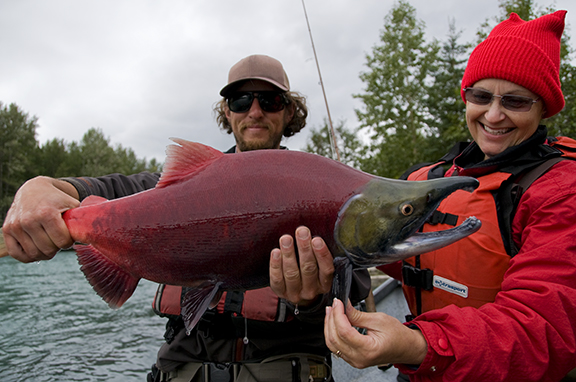 Juneau and Cooper creeks and the Russian River. Our fly rods were quickly laying the salmon egg imitation with trailing "stinger" hook out to the
each side for a quick drift downstream. Two of us had an immediate hookup! Juneau and Cooper creeks and the Russian River. Our fly rods were quickly laying the salmon egg imitation with trailing "stinger" hook out to the
each side for a quick drift downstream. Two of us had an immediate hookup!
After a short lesson on "team" casting, Lilliam reeled in a nice dolly
varden trout while Christine fought a feisty rainbow to the guide's waiting net. Us two men got in on the action quickly afterwards and the action continued almost non
-stop for 4 hours. The four of us landed 35 to 40 fish in about 5 hours on the river. We stepped out of the boat 5 or 6 times and cast our salmon egg with our fly rods to prime areas. We were
targeting dolly varden and rainbows which were all catch and release.
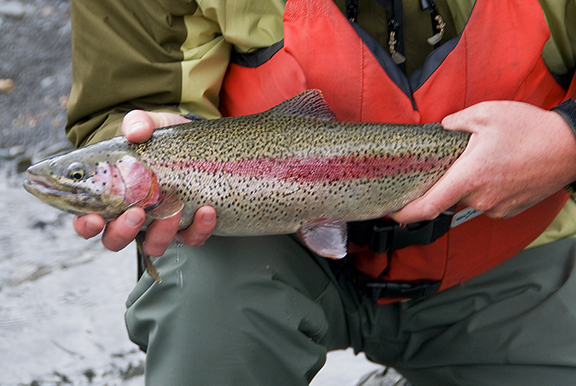 The beautiful river headwaters run through the Kenai National Wildlife Refuge and twists and turns about 82 miles down to the Cook
Inlet. Our Alaska River Adventures guide carefully controlled the boat with his oars (motors aren't allowed in this section) so that we could enjoy the gorgeous scenery, view
the eagles and any wild animals like a moose that stepped out of the Chugach National Forest, and still hit the prime fishing spots along the way. The river depth varied from 6
inches down to 10 or 15 feet deep pools in places and there are a few small rapids holding fish as well. The Kenai River has plenty of rocks and boulders all along it. The beautiful river headwaters run through the Kenai National Wildlife Refuge and twists and turns about 82 miles down to the Cook
Inlet. Our Alaska River Adventures guide carefully controlled the boat with his oars (motors aren't allowed in this section) so that we could enjoy the gorgeous scenery, view
the eagles and any wild animals like a moose that stepped out of the Chugach National Forest, and still hit the prime fishing spots along the way. The river depth varied from 6
inches down to 10 or 15 feet deep pools in places and there are a few small rapids holding fish as well. The Kenai River has plenty of rocks and boulders all along it.
Our catch consisted of perhaps 10
Arctic char up to 24 inches in length and 15 dolly varden up to one 20 inches long. The two species
are in the same family but the char reportedly has more of an orange color and black lips. We also caught and released 10 to 12
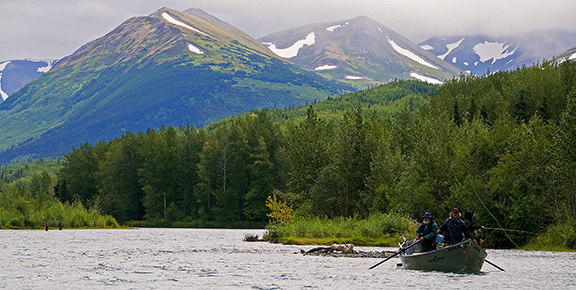 rainbow trout up to 21 inches and a few sockeye salmon up to 10
pounds. rainbow trout up to 21 inches and a few sockeye salmon up to 10
pounds.
The fish in the Kenai are all native fish according to Tyler. The rainbow
trout start spawning in May and the fishing season usually starts around the second week of June. The guide's largest trout from those waters was a 29 ½ inch long
rainbow but the biggest ever from the Kenai was 42 inches in length. Quite a few in the 12 to 15 pound range are caught and released each
week but there is quite a bit of fishing pressure on the beautiful waters.
The Kenai Sport Fishery
The rainbow trout fishery in the Kenai is very interesting, thanks to the salmon fishery. The
average return of salmon is about 4 to 5 million. About 1.2 to 1.8 million make it into the river after the commercial fishery.
"While many go on to spawn and create the runs for the future, the average harvest of sockeye
salmon in the Kenai is 1/2 million, so a good portion of them go back in the river after they've been
filleted," says fellow guide Ty Wyatt. "That creates a lot of nutrients that normally wouldn't be
there for the trout to eat. Thus, a lot of our trout are flesh eaters. They will attack a carcass."
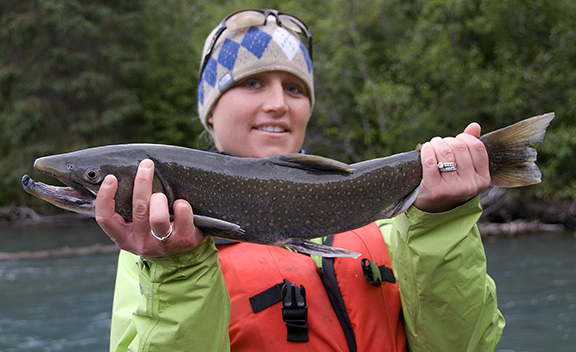 "Some of the biggest rainbow trout are in the middle Kenai River, and it is not uncommon to get a 20 pounder," he continues. "In the
premier upper Kenai, and angler can keep dollies or rainbows that are 16 inches and under. In the middle Kenai River, anglers can keep only one each of 18 inches or under.
The Russian River area off the Kenai has created an artificial food source for bears because of the fish cleaning and the carcasses that folks discard." "Some of the biggest rainbow trout are in the middle Kenai River, and it is not uncommon to get a 20 pounder," he continues. "In the
premier upper Kenai, and angler can keep dollies or rainbows that are 16 inches and under. In the middle Kenai River, anglers can keep only one each of 18 inches or under.
The Russian River area off the Kenai has created an artificial food source for bears because of the fish cleaning and the carcasses that folks discard."
Another reason that anglers catch larger rainbow trout here is the
delayed (late) maturity of the fish, according to Ty. The rainbows can obtain a larger size because it may spawn only every other year, due to that delayed maturity.
"Typically in Alaska, the resident fish don't spawn every year because the season is too short," the
guide explains. "They skip a year, so a large amount of their energy goes towards growth instead of
spawning. You will catch rainbows of different sizes with different life spans. The dolly varden are a
lake fish and they seek a lake-type environment but they come back to the rivers to spawn. They ravenously eat salmon eggs in the river."
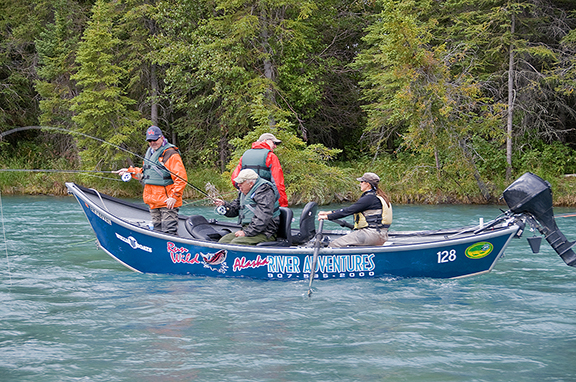 The guides work for outfitter George Hein, who has been in the business for 36 years. In fact, he was one of the first to start a guide outfitting
operation in Cooper Landing. He operates the "walk and stalk" trips using his drift boats to move downstream. When the weather warrants, more fishing is done from the boats than out from shore in
the outfitter-provided chest high waders. The guides work for outfitter George Hein, who has been in the business for 36 years. In fact, he was one of the first to start a guide outfitting
operation in Cooper Landing. He operates the "walk and stalk" trips using his drift boats to move downstream. When the weather warrants, more fishing is done from the boats than out from shore in
the outfitter-provided chest high waders.
To get in on the great action,
contact Alaska River Adventures at 1-888-836-9027 or www.AlaskaRiverAdventures.com or email info@AlaskaRiverAdventures.com. For comfortable and very convenient
accommodations to the great fishing, we highly recommend the Hutch Bed & Breakfast in Cooper Landing. For more info, visit http://www.arctic.net/~hutch/ , phone (907) 595-1270 or email owner Shirley at hutch@arctic.net.
|